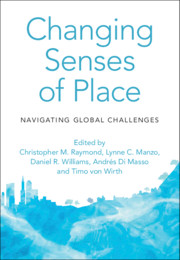Book contents
- Changing Senses of Place
- Changing Senses of Place
- Copyright page
- Dedication
- Contents
- Contributors
- Foreword
- Preface
- Acknowledgements
- Introduction
- Part I Climate Change and Ecological Regime Shifts
- Part II Migration, Mobility and Belonging
- Part III Renewable Energy Transitions
- Part IV Nationalism and Competing Territorial Claims
- Part V Urban Change
- Part VI Technological and Legal Transformations
- Part VII Design and Planning Strategies for Changing Senses of Place
- 22 Local Sense(s) of Place in a Global World
- 23 Urban Experimentation and the Role of Senses of Place
- 24 Domestic Matters
- Part VIII Conclusion
- Index
- References
22 - Local Sense(s) of Place in a Global World
Towards a Normative Framework for Spatial Planners
from Part VII - Design and Planning Strategies for Changing Senses of Place
Published online by Cambridge University Press: 15 July 2021
- Changing Senses of Place
- Changing Senses of Place
- Copyright page
- Dedication
- Contents
- Contributors
- Foreword
- Preface
- Acknowledgements
- Introduction
- Part I Climate Change and Ecological Regime Shifts
- Part II Migration, Mobility and Belonging
- Part III Renewable Energy Transitions
- Part IV Nationalism and Competing Territorial Claims
- Part V Urban Change
- Part VI Technological and Legal Transformations
- Part VII Design and Planning Strategies for Changing Senses of Place
- 22 Local Sense(s) of Place in a Global World
- 23 Urban Experimentation and the Role of Senses of Place
- 24 Domestic Matters
- Part VIII Conclusion
- Index
- References
Summary
In spatial planning, sense of place mostly entails singular, universal conceptualisations. This paper reflects on a case study of 22 purposively selected participants’ senses of place on the farm Kromdraai in Vredefort Dome World Heritage Site, South Africa in order to integrate pluralised senses of place into global policy principles for the purpose of spatial planning decision-making. A qualitative, transdisciplinary research approach was utilised to generate textual (interview) and visual data (photographs and collages) that were analysed using non-computerised thematic analysis. The research illustrates a shift away from singular universal conceptions towards the politicisation of senses of place in spatial planning by means of a democratic participatory process where power imbalances are minimised and that allowed senses of place to emerge spontaneously from the bottom-up, instead of imposing a preconceived framework in which senses of place are categorised or universalised. A flexible framework is suggested towards pluralising senses of place in spatial planning by using normative global principles in international policy.
Keywords
- Type
- Chapter
- Information
- Changing Senses of PlaceNavigating Global Challenges, pp. 287 - 300Publisher: Cambridge University PressPrint publication year: 2021
References
- 1
- Cited by



